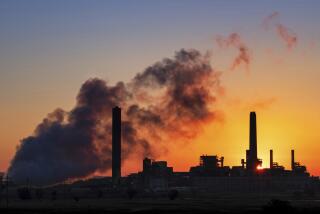Greenhouse gas emissions on the decline, EPA study says

WASHINGTON -- Emissions of heat-trapping greenhouse gases from power plants fell 10% from 2010 to 2012, as a result of more electricity being generated with natural gas rather than coal, according to new data released Wednesday by the Environmental Protection Agency.
Fossil-fuel-fired plants still contribute 40% of carbon dioxide and other emissions driving climate change, making them the single largest source of greenhouse gases, the EPA said. The data arrive as the EPA crafts new rules, at President Obama’s behest, to curtail greenhouse gas emissions from power plants.
“EPA is supporting President Obama’s Climate Action Plan by providing the high-quality data necessary to help guide common-sense solutions to address climate change,” said EPA Administrator Gina McCarthy. “Putting this data in the hands of the public increases transparency, [and] supports accountability.”
The data are part of the 3-year-old EPA Greenhouse Gas Reporting program that gathers emissions information from industries that are the largest polluters and that account for about half of all greenhouse gas emissions. The remainder of emissions comes from other far more numerous and diffuse sources, such as the country’s vehicle fleet and homes. The program is the only one that collects greenhouse gas data at the level of individual facilities from major industrial sites around the country.
The EPA website is meant to give people a detailed picture of greenhouse gas pollution in the United States. Individuals can go to the EPA website and find out how much carbon dioxide a particular power plant, paper mill, refinery or metals smelter in their town emits.
The largest polluters are mainly power plants in the South, Southwest and Midwest.
The decline in greenhouse gas emissions because of the switch to natural gas the data show may be short-lived, however. Some electric utilities have recently begun burning coal more often than gas, because coal has proved cheaper lately, according to The Energy Information Administration. The return to coal signals greenhouse gas emissions could begin rising once more this year, the EIA said.
ALSO:
Dead Boston bombing suspect tied to triple homicide
Sparks student says student might have been bullied
North Dakota oil spill raises questions about state’s boom
Follow L.A. Times National on Twitter
Twitter: @neelaeast
More to Read
Sign up for Essential California
The most important California stories and recommendations in your inbox every morning.
You may occasionally receive promotional content from the Los Angeles Times.











